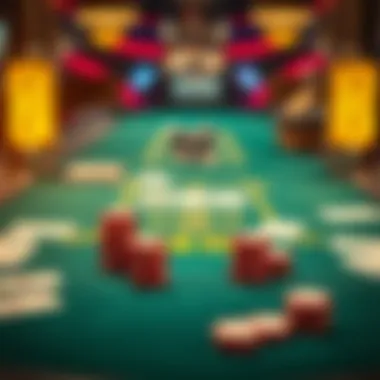Mastering Blackjack: Rules and Winning Strategies


Intro
Blackjack is a card game that has snagged the attention of players in casinos across the globe. It seamlessly blends chance and strategy, creating an environment where both beginners and seasoned gamblers can find their footing. Understanding the rules and strategies in blackjack can elevate your gameplay and enhance your enjoyment in a casino setting.
When you shuffle through the basic guidelines and the intricacies of the game, you’ll unearth a treasure trove of tactics that can significantly influence your outcomes. From understanding the flow of the game to mastering the delicate interplay between your decisions and the dealer's moves, the world of blackjack offers a complexity that is both enticing and rewarding.
This article aims to peel back the layers, giving you a thorough insight into the rules, variations, and strategies that define blackjack. By the end, you'll not only comprehend the essential mechanics governing the game but also discover strategic insights that can tilt the odds slightly in your favor.
"Understanding the rules is just the start; mastering them is where the fun begins."
As we delve deeper, we aim to explore every angle of this fascinating game, arming players—regardless of experience—with knowledge that can lead to a more informed and successful casino experience.
Game Strategies
In order to excel in blackjack, players need to grasp various strategies that can significantly impact their chances of winning.
Beginner Tips for Casino Games
Starting your blackjack journey can be both exciting and a bit daunting. Here are a few tips that can set you on the right path:
- Learn the Basic Rules: Familiarize yourself with what constitutes a winning hand, and understand how to count the points.
- Start Small: Betting smaller amounts can help you gauge the game without risking too much.
- Stay Patient: Blackjack isn’t a sprint but more of a marathon. Take your time and avoid making hasty decisions.
Advanced Strategies
As players gain experience, they may wish to adopt more advanced techniques. Here are strategies worth considering:
- Card Counting: This is a method where players track the ratio of high cards to low cards remaining in the deck, aiding in betting decisions.
- Bet Sizing: Adjusting your bets based on the count or your confidence can maximize your winnings while minimizing losses.
Gambling Fundamentals
A solid foundation in gambling principles is essential for anyone keen on blackjack.
Understanding Betting Systems
Various betting systems, like Martingale or Fibonacci, can add structure to your gameplay. While these systems don't guarantee wins, they can help manage your bankroll effectively. It’s crucial, however, to understand the risks associated with each.
Bankroll Management Essentials
Keeping an eye on your bankroll is perhaps one of the most fundamental aspects of responsible gambling. Here are some guidelines:
- Set a budget: Decide how much you’re willing to spend before sitting down to play, and stick to it.
- Divide Your Bankroll: Split your chip stack into smaller portions to elongate your gaming sessions and manage risk.
In summary, understanding blackjack at casinos requires more than just knowing how to make a hand. It involves a delicate mix of strategy, discipline, and awareness of gambling fundamentals. As you get acquainted with these aspects, you’ll find yourself not just playing the game but truly engaging with it on a deeper level.
Intro to Blackjack
Blackjack has carved a significant niche in the world of gambling, being hailed as one of the most beloved card games in casinos. Its allure stems not just from the potential for significant financial reward, but also from a combination of strategy, chance, and psychological warfare between player and dealer. Understanding the nuances of this game is crucial, whether you’re a seasoned player or absolutely new to the blackjack table. Without grasping the essential rules and strategies, embarking on a Blackjack journey could feel more daunting than a deer caught in the headlights.
Historical Context and Evolution
The roots of blackjack can be traced back centuries, weaving through various cultures and contexts. Its journey begins in French casinos during the 1700s with a game called "Vingt-et-Un," which directly translates to "Twenty-One." From the fertile grounds of Europe, the game found its way to the shores of the Americas, where players soon began to adapt the rules. At one point, casinos in the United States even offered a special bonus payout for players who could achieve a hand composed of the ace of spades and a black jack, thus originating the name we know today. This historical underpinning showcases how blackjack evolved, responding to the tastes and preferences of players throughout time.
Objective of the Game
At its core, the objective of blackjack is straightforward: secure a hand value as close to 21 as possible without exceeding it. Players strive to beat the dealer's hand through a balance of calculated risk-taking and prudent play. The allure lies in the tension of each decision weighing the odds of hitting another card versus standing with your current hand. This dynamic makes for a compelling gaming experience, requiring not just luck, but also a keen understanding of probability and strategy. Players often find themselves pondering whether to 'hit,' 'stand,' or employ other tactics like doubling down or splitting pairs—each choice invoking a different layer of strategy.
Understanding the objective of the game allows players to approach the table with clarity and purpose, ultimately improving their chances of success.
Understanding the Basics of Blackjack
Understanding the basics of blackjack is like laying the foundation for a house. No matter how elaborate or well-designed the structure may become, without a solid base, it can all come crashing down. In the realm of casinos, where the stakes are high and the excitement palpable, grasping the fundamental aspects of blackjack becomes paramount for any player aiming for success.


At its core, blackjack is more than just a game of chance; it's a strategic battle between the player and the dealer. Familiarity with the basic rules and gameplay allows players to make informed decisions, enhancing their overall experience. Additionally, a solid grasp of the game's mechanics can significantly shift the odds in favor of the player, highlighting the importance of developing an informed and strategic approach.
Card Values and Types
In blackjack, each card holds a specific value, and understanding these values is crucial for any player. The numbered cards from two to ten hold their face value. For example, an 8 is worth 8 points. On the other hand, face cards like Kings, Queens, and Jacks are valued at 10. The Ace, however, is unique. It can either be worth 1 or 11 points, depending on what benefits the hand the most.
This flexible value system can set the stage for some keen decisions at the table. A player must count cards quickly and accurately, deciding whether to stand, hit, or use strategic plays like double down or split, based on their hand value. The interplay between these card values defines the gambling landscape, making it imperative for players to have a firm notion of what each card means.
The Role of the Dealer
The dealer acts as the gatekeeper of the game, controlling the flow and enforcing the house rules. Understanding the dealer's role is crucial. They not only deal the cards, but they also stand as the opponent for every player at the table. Typically, the dealer must follow specific guidelines, such as standing on a hard 17 and hitting on anything lower.
This clarity in rules can sometimes offer players insight into how to approach their gaming strategies. If a player knows that the dealer is obligated to hit on a soft 17, they might be inclined to be more aggressive with their overall betting strategy. For instance, if the dealer's upcard reveals a low number, players can find opportunities to maximize their bets, leveraging the insight they gain from understanding the dealer’s game mechanics.
Setting Up the Game
Setting up a game of blackjack involves several straightforward steps, but the importance can’t be understated. First, players usually gather around a semicircular table to accommodate the dealer and everyone else in a suitable manner. Players will place their bets in designated betting boxes that are often outlined on the felt.
Once bets are placed, the dealer distributes two cards to each player and themselves, with one of their cards often facing up for players to see. The anticipation builds as players assess their positions based on their card values against the dealer’s upcard.
A crucial aspect of setting up the game is observing the betting limits, which vary from casino to casino. Players must carefully plan their wagers, keeping within the table’s min and max bets. This knowledge serves not only to maintain the discipline necessary for good bankroll management but also to avoid any potential pitfalls involved in high-stakes games that can drain a bankroll quicker than a flush can be discarded.
The goal is to have the best hand that is equal to or less than 21 points, without exceeding this limit.
In summary, understanding the basics sets the stage for more advanced strategies in blackjack. Players equipped with knowledge about card values, the dealer role, and game setup are better positioned to navigate the exhilarating world of blackjack in casinos effectively.
Basic Gameplay Mechanics
Understanding basic gameplay mechanics is crucial for anyone stepping into the world of blackjack. These mechanics lay the foundation for gameplay, influencing not just individual decisions but the overall outcome of the game. When players grasp these elements, they not only enhance their own experience but also increase their chances of success at the table.
Dealing the Cards
At the heart of blackjack is the dealing of cards. Each player receives two initial cards, while the dealer typically gets one card face up and one face down. This initial deal sets the stage for all subsequent play. Players can see their own cards, allowing for personal strategy formulation, while the dealer's hidden card creates an air of suspense.
The way cards are dealt can vary slightly based on the specific rules of the casino, but the essence remains the same: the goal is to reach a hand total of 21 or as close as possible without busting, which means exceeding 21. For novice players, it’s worth noting that mastery of the dealing process will aid in understanding how to react to the dealer’s visible card, directly impacting decisions going forward.
Understanding the Moves: Hit, Stand, Double Down, and Split
Once the cards are dealt, players are faced with several options for how to proceed. Understanding these moves is paramount:
- Hit: This action involves taking an additional card to potentially improve one’s hand. It’s risky, but can be necessary when the current hand value is low.
- Stand: Opting to stand means the player feels satisfied with their hand total and doesn’t wish to take more cards. This decision can be a strategic one, especially against the dealer’s upcard.
- Double Down: Doubling down allows players to double their original bet in exchange for receiving exactly one more card. This move can be advantageous when players feel confident about improving a strong hand.
- Split: If a player’s initial two cards are of the same value, they may choose to split them into two separate hands, subsequently allowing for a chance to win multiple bets. However, this maneuver strategically requires careful consideration of future moves.
Comprehending these strategic options helps create a more engaged and proactive player. Each choice has unique implications and can be the difference between victory and defeat.
The Importance of the BlackJack Hand
Achieving a blackjack, which is an ace plus a 10-value card, is the pinnacle of the game. It creates not only a significant lead over the dealer but often increases the payout as well. This specific hand holds importance beyond just value; it represents the excitement and allure of the game itself. To be dealt this outcome early can set a powerful tone for a player's experience, often creating a sense of confidence.
Moreover, recognizing the conditions under which a blackjack occurs is critical. Many casinos offer bonuses or higher payouts for hitting a blackjack over standard wins, making this hand a central focus of strategy. The stakes are higher, and players are encouraged to adjust their subsequent game play to take advantage of this rare and prized outcome.
"A blackjack in hand typically translates to a smile on one's face; nothing beats that feeling of a winning hand."
In sum, understanding these basic gameplay mechanics is not just about knowing the rules; it’s about developing a deeper appreciation for the dynamics at play within blackjack. Mastering how to deal, the significance of moves, and the value of a blackjack hand can lead to improved performance and enjoyment at the table. With practice, players enrich their skills and heighten their casino experiences.
Rules Specific to Casino Environments
When stepping into the bustling world of casinos, knowing the rules specific to casino environments becomes paramount for any blackjack player. These rules dictate aspects of play that can significantly affect strategies, outcomes, and ultimately your enjoyment of the game. Given the high stakes and the myriad choices offered in different establishments, familiarizing yourself with these rules doesn't just serve as a safety net; it empowers you, enhancing your chances of a fruitful gaming experience.
Table Limits and Bet Sizes
Each blackjack table comes adorned with a specific limit, dictating the minimum and maximum bets players can place. This can range from a modest dollar to thousands depending on the casino's clientele. It's key to choose a table that aligns with your comfort level—bite too much off the plate, and you risk losing it all too soon. Conversely, a low limit might frustrate those looking to make bigger plays.
For example, imagine you walk up to a table with a minimum bet of $10, but your strategy involves betting less initially while gauging the dealer's tendencies. In such a scenario, you could find yourself stuck unless there's room for accommodations, like side betting or joining a more suitable table. Here's a brief rundown of the types associated with table limits:


- Low Stakes: $5 to $25; ideal for beginners or casual players.
- Mid Stakes: $50 to $200; attracts more experienced players willing to risk more.
- High Stakes: $500 and up; generally a magnet for seasoned gamblers who like playing big.
Casino Variants of the Game
It's refreshingly diverse when you survey various blackjack tables. Casinos often offer unique variants of the classic game, each seasoned with their own special rules and twists. Variants could incorporate elements designed to attract different demographics or cater to players seeking varied experiences.
For instance, many casinos feature Spanish 21, a variant where the dealer has no 10s in the deck but several rule changes can actually favor players. Another one is Blackjack Switch, where players can swap cards between two hands—this adds an entire layer of complexity. Other enjoyable types include Double Exposure Blackjack, where both dealer cards are shown, and Progressive Blackjack, incorporating a common side bet for a chance at increased jackpots. Knowing the specific variant you're playing will direct your strategy and bets accordingly.
House Rules: Understanding Casino-Specific Guidelines
Every casino, akin to its own country, has its unique set of house rules that govern gameplay. These house rules can cover everything from when the dealer must hit or stand, to whether or not surrendering is an option. Engaging in a game without grasping these subtle guidelines could mean the difference between a tantalizing win and a disappointing loss.
Some common house rules include:
- Dealer Stand on Soft 17: Many casinos enforce a rule where the dealer must stand on a soft 17 (a hand containing an Ace valued as 11).
- Surrender Options: Some tables allow players to surrender their hands, recovering half their bet if they feel the situation is unfavorable.
- Insurance Bets: When a dealer shows an Ace, players can opt for an insurance bet, typically equaling half their original bet, hoping the dealer has a 10 underneath.
Understanding these guidelines ensures you won't find yourself in a bind when the dealer flips over their cards. As always, asking the dealer or observing other players can clarify any lingering uncertainties.
Remember, while learning the complex rules may seem daunting, it’s part of the game’s charm and strategy.
Arming yourself with knowledge about table limits, game variants, and house rules brings a tactical advantage. Recognize that by doing so, you transform from just another player at the table into a confident competitor ready to engage in the thrilling dance that is blackjack.
Strategies for Successful Play
When it comes to mastering blackjack, a game often associated with crisp suits and the clattering of chips, diving into strategies is essential. Developing a sharp, tactical approach significantly elevates one’s chances of turning the odds in their favor. This section delves into the myriad of strategic elements that form the backbone of successful gameplay, ultimately enhancing both enjoyment and profit potential for players.
Basic Strategy Charts Explained
Basic strategy charts serve as essential tools in a blackjack player’s arsenal. These charts are designed based on mathematical probabilities that guide players on the best possible move based on their hand and the dealer’s upcard. Understanding how to read and utilize these charts is crucial.
- What’s on the Chart?
The chart provides a comprehensive overview categorized by the player’s total hand value against the dealer’s visible card. It typically outlines whether to hit, stand, double down, or split. - Why Use It?
By following these recommendations, players can lower the house edge, increasing their chances of winning. It’s like having a trusty compass in uncharted waters. - Practical Application
Familiarizing oneself with the chart before hitting the casino floor is important. The more comfortable a player feels with it, the more intuitive their decisions become during gameplay.
Utilizing a basic strategy chart is akin to wielding a map through a dense forest; it might take time to learn, but it saves hours of wandering around cluelessly.
The Role of Probability in Gameplay
Probability forms the backbone of blackjack strategies. Every card dealt, every hit taken, and every bet placed is steeped in chance. Understanding how to compute these probabilities can be a game-changer for players.
- Calculating Odds
At its core, blackjack hinges on the probabilities of card values. Players should progressively familiarize themselves with the odds of various outcomes. For instance, knowing the probability of busting with a certain hand helps in decision-making. - Dealer Behavior
The dealer's hidden card adds another layer. Players often need to estimate what the dealer could have while adjusting their tactics accordingly. Understanding that the dealer must stand on 17 or above can guide smart moves. - Risk Assessment
Knowing the risks attached to every decision can prevent hasty choices fueled by instinct rather than logic.
Ultimately, grasping the nuances of probability in blackjack polishes one’s gameplay, akin to sharpening a knife before cutting through thick steak.
Advanced Techniques: Card Counting and Beyond
For players wishing to take their blackjack strategy to the next level, card counting represents a complex yet rewarding avenue. Card counting isn't just a technique; it’s a discipline that requires diligence and focus.
- Understanding the Basics of Card Counting
Card counting revolves around tracking high and low cards played, allowing players to gauge the composition of remaining cards. A higher ratio of face cards and tens remaining enhances a player’s odds. - Strategies for Counting
- Implementing Card Counting
While useful, implementing card counting demands discretion. Players must blend their strategies seamlessly without drawing attention from casino staff.
- Hi-Lo System
This simple method assigns values to cards: low cards (2-6) get a +1, high cards (10-A) receive a -1, while middle cards (7-9) are ignored. Tracking this throughout the game helps establish a rough count. - More Complex Systems
For those who want to delve deeper, techniques like the Omega II or Wong Halves can provide greater precision, although they require more practice.
Card counting can feel like navigating a chessboard, where every move dictates the next course of action. It’s transformative in the hands of a player who can master it.
Bankroll Management for Blackjack Players
Managing your bankroll is crucial when sitting at a blackjack table. It serves as the foundation of your gambling strategy and directly influences your overall experience and success. Effective bankroll management helps players balance enjoyment with the potential for losses, allowing you to stay in the game longer and mitigate risky behavior. Without a clear plan, it's all too easy to find yourself in the red, leaving you frustrated and out of cash in no time.
Setting a Budget
Before you even think about placing a bet, it’s wise to establish how much money you’re willing to spend. This isn’t just a figure pulled from thin air. Take into account your overall financial situation. Will this money affect your lifestyle? If the answer is yes, then it might be best to step back and reconsider your stakes.
- Decide on a Total Amount: This should be an amount that you can afford to lose without impacting your daily life. This allows you to play with a clear mind, free from the stress of financial strain.
- Break It Down: Segment your budget into smaller portions for each gaming session. This approach helps to maintain discipline and prevents you from splurging your entire bankroll in one rush.
- Stick to the Plan: It's easy to deviate from your set budget, especially when you're on a winning streak. Stay firm and quit while you're ahead or if your set limit is reached.


Tracking Wins and Losses
Keeping tabs on your wins and losses is an often-overlooked aspect of gambling. This not only allows you to see how well you’re doing but also helps in understanding your gaming habits over time.
- Create a Record: Use a simple notebook or a spreadsheet to jot down each session’s outcomes. Include details such as the date, amount played, wins, and losses.
- Analyze Trends: After several gaming sessions, review your notes. Are you more successful on weekends? Do certain tables bring you better fortune?
- Stay Objective: Don’t allow emotions to color the data. Just because you had a great streak doesn’t mean you can push your luck indefinitely. A thoughtful examination will guide your decisions going forward.
Adjusting Bet Sizes Based on Bankroll
As you track your performance, it’s essential to adjust your bets according to your bankroll. This method helps manage risk and can significantly extend your playtime.
- Use a Percentage of Your Bankroll: A common rule of thumb is to wager only 1% to 5% of your total bankroll per round. This approach allows for fluctuations while still providing a chance to build your stack.
- Adapt to the Situation: If you’re winning consistently, consider increasing your bet slightly. Conversely, if luck seems to have vanished, tighten your belt and reduce your bets.
- Set Win and Loss Limits: Before starting, set clear thresholds. For instance, if you win 50% of your bankroll, think about cashing out some of your winnings. Likewise, if you reach a loss limit, don’t hesitate to walk away.
"A budget is telling your money where to go instead of wondering where it went."
When managed well, your bankroll becomes a protective barrier against impulsive decisions and erratic behavior. Remember, gambling should be a fun, engaging activity. By adhering to good bankroll management practices, you not only enhance your chances for success but also ensure a more enjoyable gaming experience.
Common Mistakes and How to Avoid Them
Blackjack is a game packed with excitement, strategy, and a fair share of risks. While experienced players may navigate the tables with ease, it’s common for novices and even seasoned players to trip over some fundamental mistakes. This section delves into those common pitfalls and how to sidestep them. Understanding these mistakes can not only save money but also enhance your overall experience at the casino. Let’s break down three significant areas where players often stumble.
Misunderstanding the Basic Rules
One of the most prevalent errors among beginners is failing to grasp the basic rules of blackjack. This game isn’t just about getting close to 21; there are nuanced strategies involved. For instance, players might not understand the significance of the dealer's upcard. If the dealer shows a low card, players may be tempted to hit on hands that would normally be deemed strong. This can lead to unnecessary losses.
Moreover, misunderstanding the difference between a "hard" hand and a "soft" hand can lead to poor decision-making. A hard hand does not contain an Ace valued as 11; conversely, a soft hand does. This distinction affects how players should approach their strategy and choices regarding hitting or standing. Recognizing this difference allows for more informed gameplay—understanding when to be aggressive or cautious can make a significant difference in winning percentages.
Ignoring Bankroll Management Principles
Money management—or lack thereof—can be the downfall of many blackjack players. One of the essential aspects is setting a budget before you even approach the table. This budget should be an amount you are comfortable losing and should not alter based on emotions or winning streaks. Yet, it’s surprising how often players get drawn into the moment.
Tracking wins and losses translates into a clearer picture of your financial journey. Some players keep their chips separate, assigning color codes to different amounts. For example, having red chips represent smaller bets and green chips for larger sums can help you visualize your bankroll's status. Moreover, adhering to a defined betting strategy based on your bankroll size—like the conservative ‘1-5% of your bankroll per bet’ approach—provides a safety net, ensuring you're still in the game even after a few losses.
Overreliance on Superstitions
When people engage in games of chance, it's not rare for them to lean on superstitions. But in blackjack, this tendency can lead players down a rocky road. Every player is unique, and strategies that have worked well for one person may not yield the same results for another.
Consider the myth that wearing certain clothing or carrying specific charms can influence card draws. While it may provide a psychological comfort, it doesn't impact the odds of the game in any meaningful way. Players often waste precious time and energy on rituals instead of focusing on actionable strategies. Making decisions grounded in understanding card probability, table dynamics, and dealer tendencies is far more effective.
In summary, avoiding these common mistakes can make a world of difference to a blackjack player. Understanding the rules thoroughly, managing your bankroll wisely, and steering clear of superstitions set a solid foundation for any player looking to thrive in the world of blackjack.
By honing your skills in these areas, not only can you elevate your gameplay but also enjoy the process more fully. So, roll up those sleeves, keep these points in mind, and step up your blackjack game.
Closure
In wrapping up our exploration into the world of blackjack at casinos, it's essential to recognize the profound impact that understanding the game can have on one's overall experience. More than just a pastime, blackjack embodies a blend of strategy, luck, and social interaction. At its core, having a solid grasp of the rules and mechanics not only enhances gameplay but also instills confidence in players—critical when you're seated at a bustling table.
The various aspects discussed, from the basics of card values and dealer rules to the strategies for success and bankroll management, all serve a singular purpose: to equip players with the knowledge they need to navigate the complexities of the game with ease. A well-prepared player not only enjoys the game more but is also in a prime position to capitalize on winning opportunities.
"Knowledge is power, especially in the realm of gambling."
As players make informed decisions and refine their strategies, they can potentially tilt the odds in their favor, which is ultimately the goal for many who gamble. Even small adjustments in gameplay—like knowing when to stand or hit, or how to properly manage bets—can result in substantial differences over time.
Additionally, the importance of ongoing education and practice cannot be understated. This ever-evolving environment of casinos and the diverse strategies emerging among seasoned players mean that staying updated is key. To sum up, the conclusion of our article is clear: blend knowledge with practice, and arm yourself to engage fully in the dynamic world of blackjack.
Recap of Key Points
Throughout this journey into blackjack, several points stood out that are pivotal for both new and seasoned players.
- Understanding Rules: Familiarity with the basic gameplay rules lays the groundwork for effective participation.
- Recognizing Strategies: Employing strategic decisions based on probability can enhance winning potential significantly.
- Importance of Bankroll Management: Setting limits and adjusting bets based on prevailing circumstances are critical components for long-term enjoyment and success.
- Common Mistakes: Awareness of common pitfalls, like ignoring bankroll principles or indulging in superstitions, can lead to a more grounded approach to the game.
- Dealer Role and House Edge: Knowing how casino rules affect the game informs your strategy and expectations.
Understanding these elements collectively creates a map for navigating the vibrant but intricate world of blackjack.
Encouragement to Explore and Practice Further
As with any skill, practice makes perfect, and blackjack offers ample opportunity for that. No one starts as an expert; the game's intricacies can only be truly appreciated through experience.
- Engage with online simulators or practice tables at your local casino to hone your skills without the pressure of real stakes.
- Connect with fellow enthusiasts and strategists in communities on platforms like reddit.com to exchange insights and learn from each other's experiences.
- Delve into literature or guides focused on advanced strategies—sometimes a simple tweak in approach can lead to notable improvements.
In essence, the more you immerse yourself in the nuances of blackjack, the better equipped you'll be to tackle the tables with confidence and poise. So, whether you are a novice just dipping your toe in or a seasoned player brushing up on your strategies, there’s always room to grow and enjoy this captivating game.







